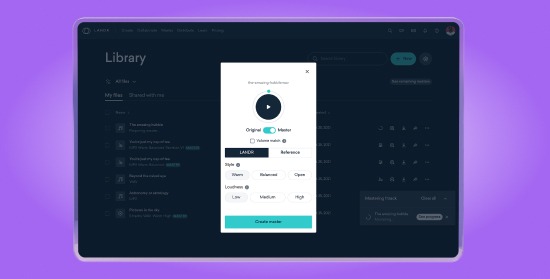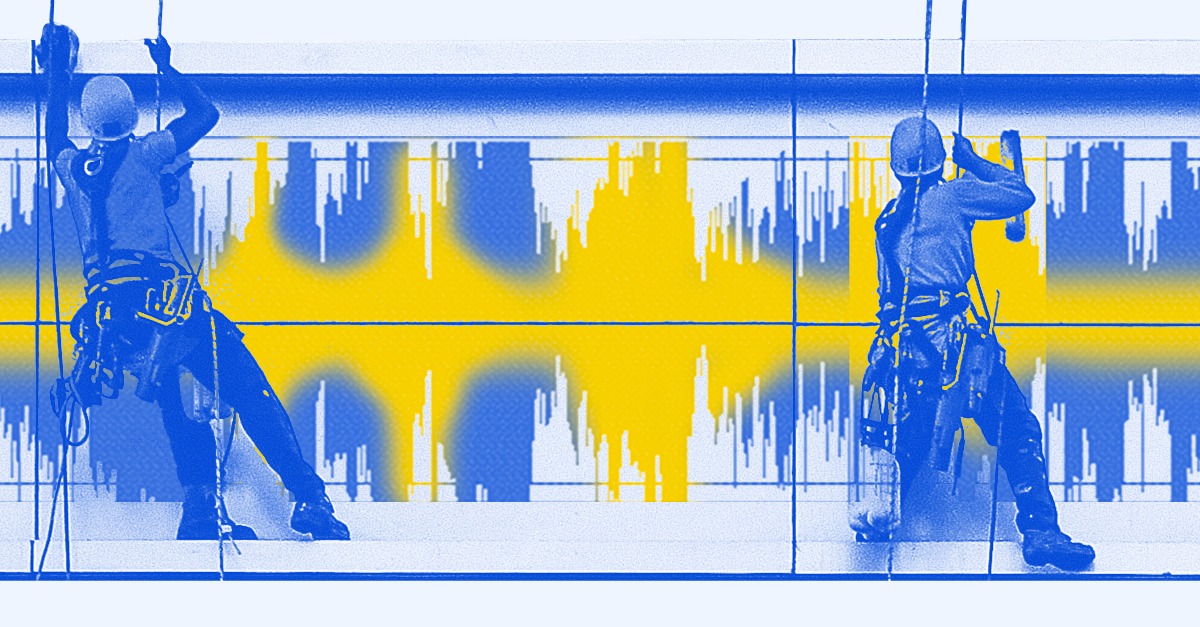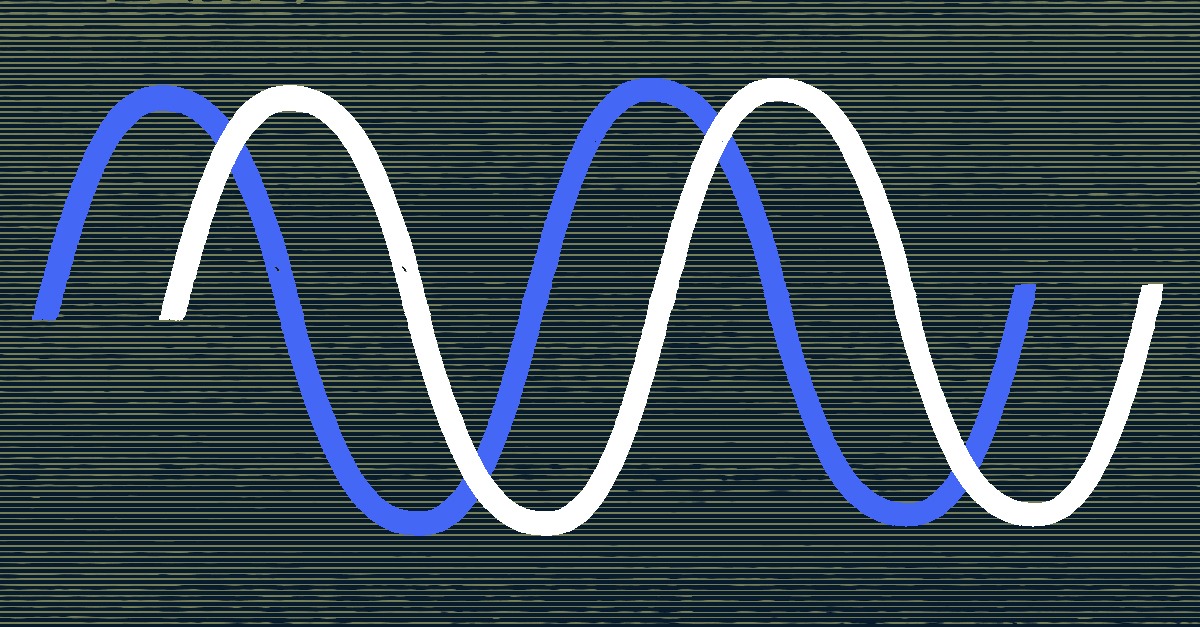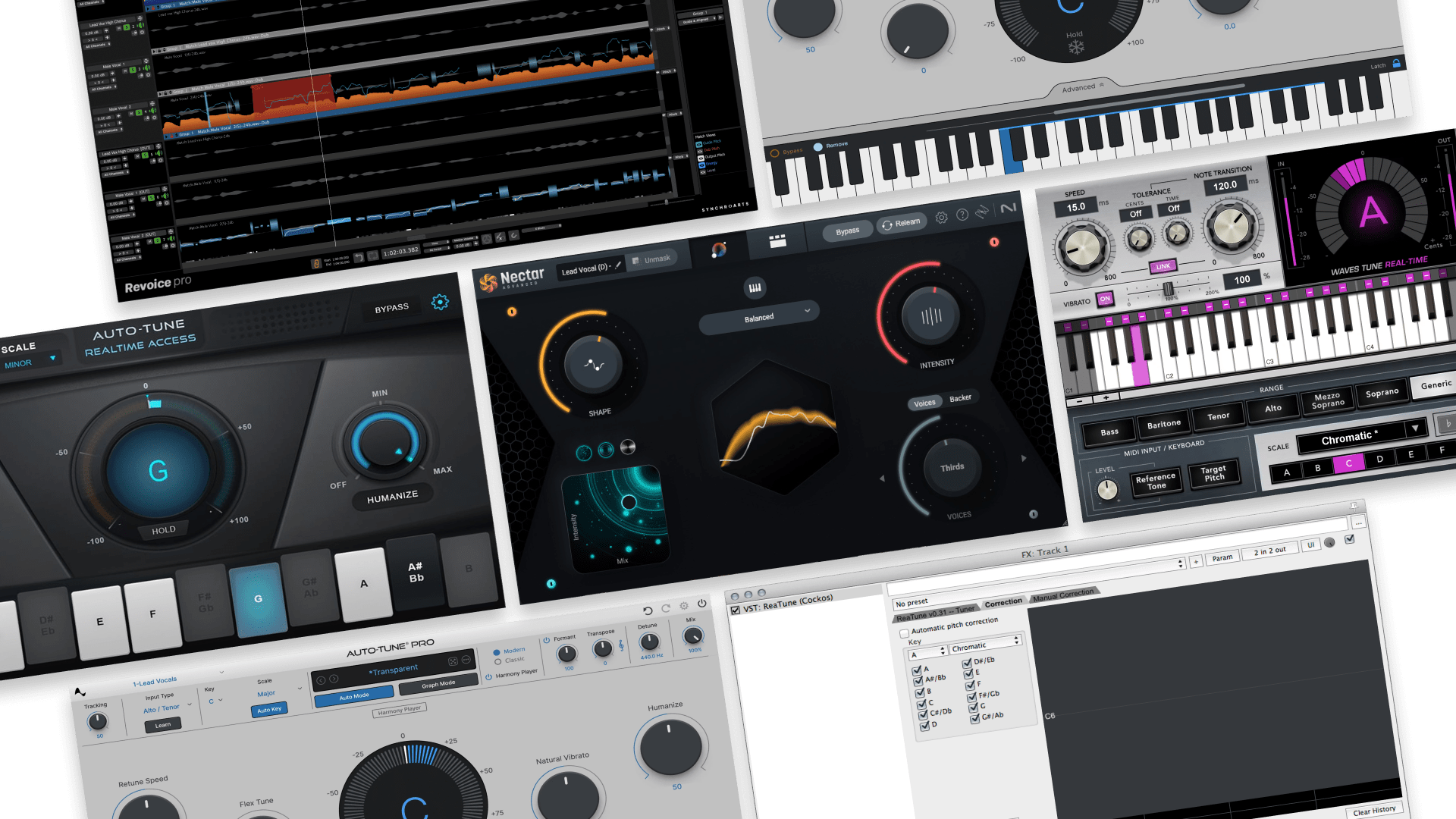
Sound Frequency: How to Use the Frequency Spectrum For Better EQ
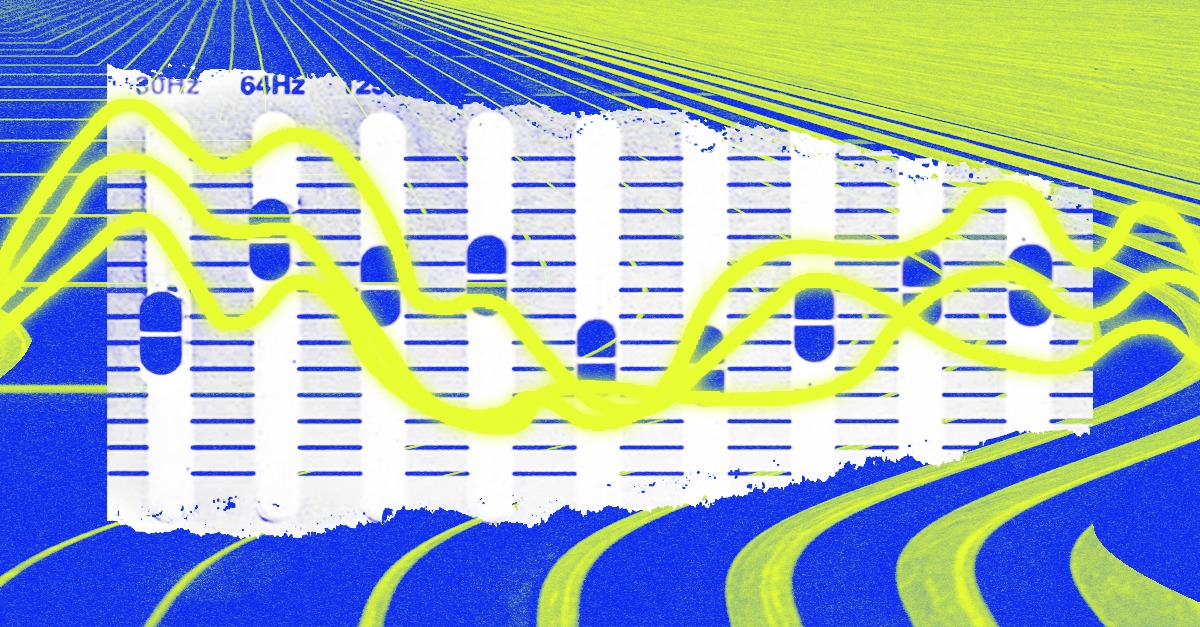
The most basic processes for mixing music are compression, EQ and reverb.
EQ is the technique in mixing that deals with sound frequency content.
To master EQ you need to understand what audio frequency is and how it relates to the instruments in your mix.
But learning to interpret music by frequency is difficult. It can feel like a dry and scientific way to think about the sounds in your mix.
It’s worth it though. If you understand some of the basic concepts about frequency, you’ll have a much easier time making critical mix decisions.
In this article I’ll explain everything you need to know about sound frequency.
What is sound frequency?
Frequency is the property of sound that we associate with musical pitch.
Frequency is the property of sound that we associate with musical pitch.
Technically, frequency is the number of cycles of a periodic waveform that occur over a set duration. Audio frequency is measured in Hertz, or cycles per second.
Frequency may seem like a technical concept, but understanding what it actually means will help you mix better.
Learning sound frequency ranges
Every pro mix engineer knows that different instruments have different amounts of energy in different frequency ranges.
You can work with a rough estimate of the main frequencies a sound occupies, but every recording is unique.
To get a truly balanced mix you’ll have to judge each sound individually. The only way to do that is by identifying its key frequencies by ear.
If you can do that effectively you’ll have a much easier time EQing your sources correctly.
You can go way beyond “bass, middle treble” when you know how to break down the frequency spectrum into key areas.
You can go way beyond “bass, middle treble” when you know how to break down the frequency spectrum into key areas.
Here are the sound frequency ranges that matter most for your mixes.
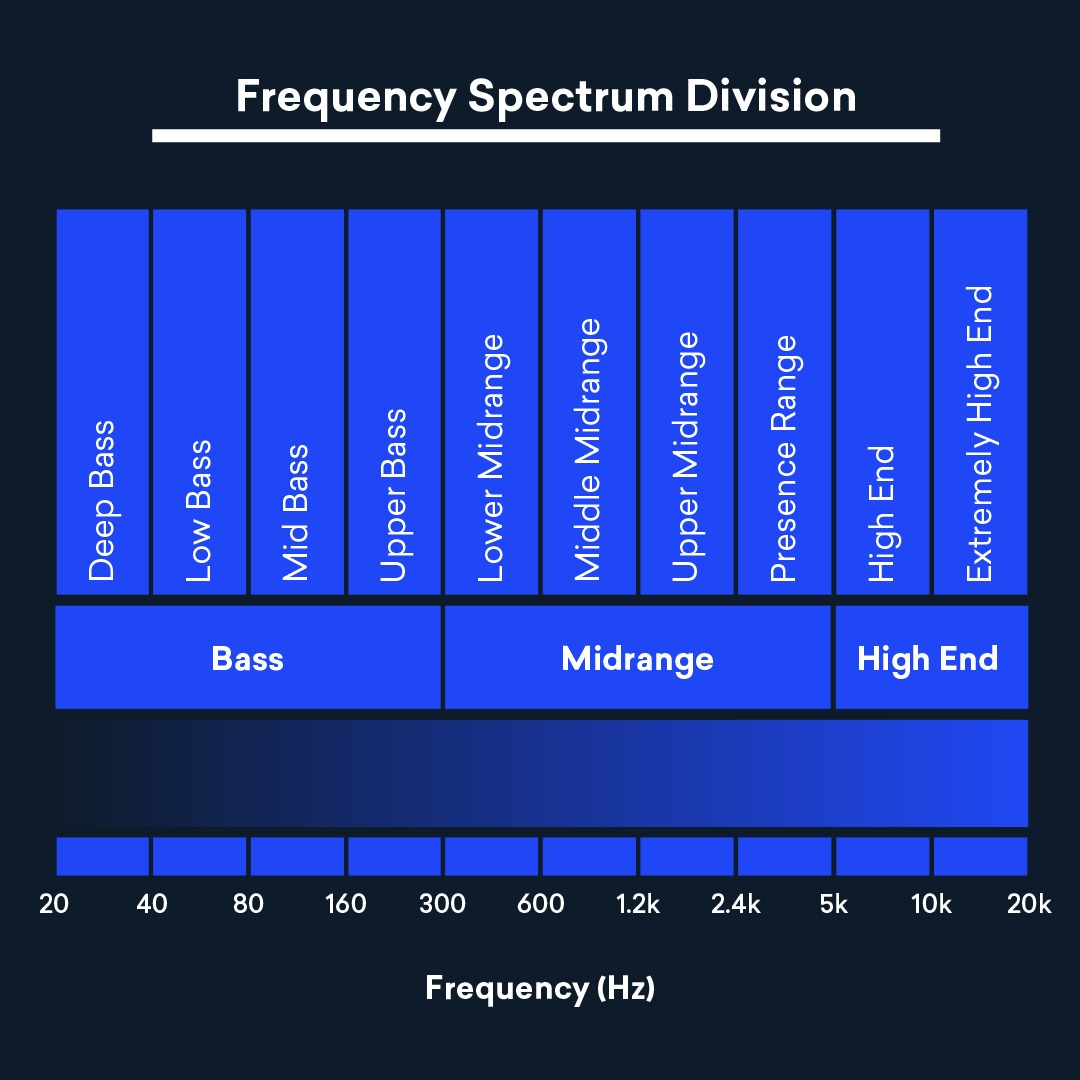
Sub bass frequencies
Sub bass extends roughly from 20-40 Hz. These are the frequencies at the absolute lower limit of human hearing.
Almost all speaker systems struggle to reproduce these frequencies accurately—and if they do, they’re more felt than heard.
In most cases, you should leave your high-pass filters set at least high enough to remove these frequencies from your tracks.
You may want to leave some sub bass in the elements in your mix that need to extend down the furthest, but be careful.
Leaving excess energy in this range does more harm than good.
Low bass frequencies
Next up is the low bass. This range extends from about 40-80 Hz.
This is a crucial area of your mix for foundational elements like kick and bass. It’s also a range where many inexperienced mix engineers struggle to get good results.
To mix the low bass well you’ll have to have a clear idea of what needs to go there—and what should stay out.
To mix the low bass well you’ll have to have a clear idea of what needs to go there—and what should stay out.
You might think that boosting the bass across every element in your mix will help you get a big low end.
In fact, the opposite is true. You need to leave enough space in your mix for your main bass instruments to command the low end.
Crowd the low bass frequencies too much and your kick and bass will lack punch and definition.
And when it comes to these two elements, you’ll have to make a decision about which will be the lowest of the low.
If you don’t they’ll end up competing with each other.
But once you’ve decided, emphasizing a little bit in this range can help bring out the lowest harmonics in your foundational instruments—just don’t go too far!
Upper bass frequencies
Your bass frequency range extends up from there to roughly 200 Hz.
Any bass elements in your mix that aren’t focused in the low bass should live here. Still, you’ll have to make clear decisions about how to place each element that occupies this range.
The lower harmonics of rack and floor toms and much of the power of your bass instruments can be found in this area, so be careful.
Low midrange frequencies
The low midrange is where the sense of power in your chordal and melodic instruments should lie.
I’m talking about elements like electric guitar, piano, synth leads, and in some cases even vocals if they are very upfront in the mix.
In fact, there can be so much going on in the low mids of a mix that it’s impossible to say exactly which instruments should sit here.
Make sure to clear this range in your bass instruments that are already commanding the low end.
Scooping some low mid out of kick drums and bass guitar is common practice in mixing.
Scooping some low mid out of kick drums and bass guitar is common practice in mixing.
Midrange frequencies
The main midrange frequencies extend from 500 Hz to roughly 1.5 kHz.
These frequencies are extremely important for the clarity and separation of different instruments.
Too much energy in the critical 500-1000 Hz area can give your mix a cloudy, boxy sensation.
Too much energy in the critical 500-1000 Hz area can give your mix a cloudy, boxy sensation.
Not enough can leave your mix sounding thin and anemic.
Experiment to hear whether your sounds benefit from subtle EQ in this region. In some cases you may find leaving a little extra midrange helps your sounds hold their own in the mix.
Other times it might need to get cut!
Upper mid frequencies
The upper mids make up the rest of the midrange, spanning from 1.5 Hz up to about 5k.
This is another critical range where excess energy can cause mix issues.
Too much high mid frequencies can lead to a harsh-sounding mix—one of the most glaring signs a track has been mixed by an inexperienced engineer.
It’s tempting to boost frequencies in this part of the spectrum. Doing so pushes them forward in the mix, but be careful.
Make sure to take frequent breaks from mixing to give your ears a chance to rest. Ear fatigue gives you a tendency to overhype your upper mids from a perceived lack of punch.
Ear fatigue gives you a tendency to overhype your upper mids from a perceived lack of punch.
Monitoring too loud can have a similar effect. Protect your ears and keep your mix at a reasonable volume level while working.
One instrument that engineers commonly push in this range is the kick drum source (mic or sample) that adds the sense of “point” that allows it to push through a dense mix.
Boosting an inside kick drum mic at 2.5 kHz can have a powerful effect!
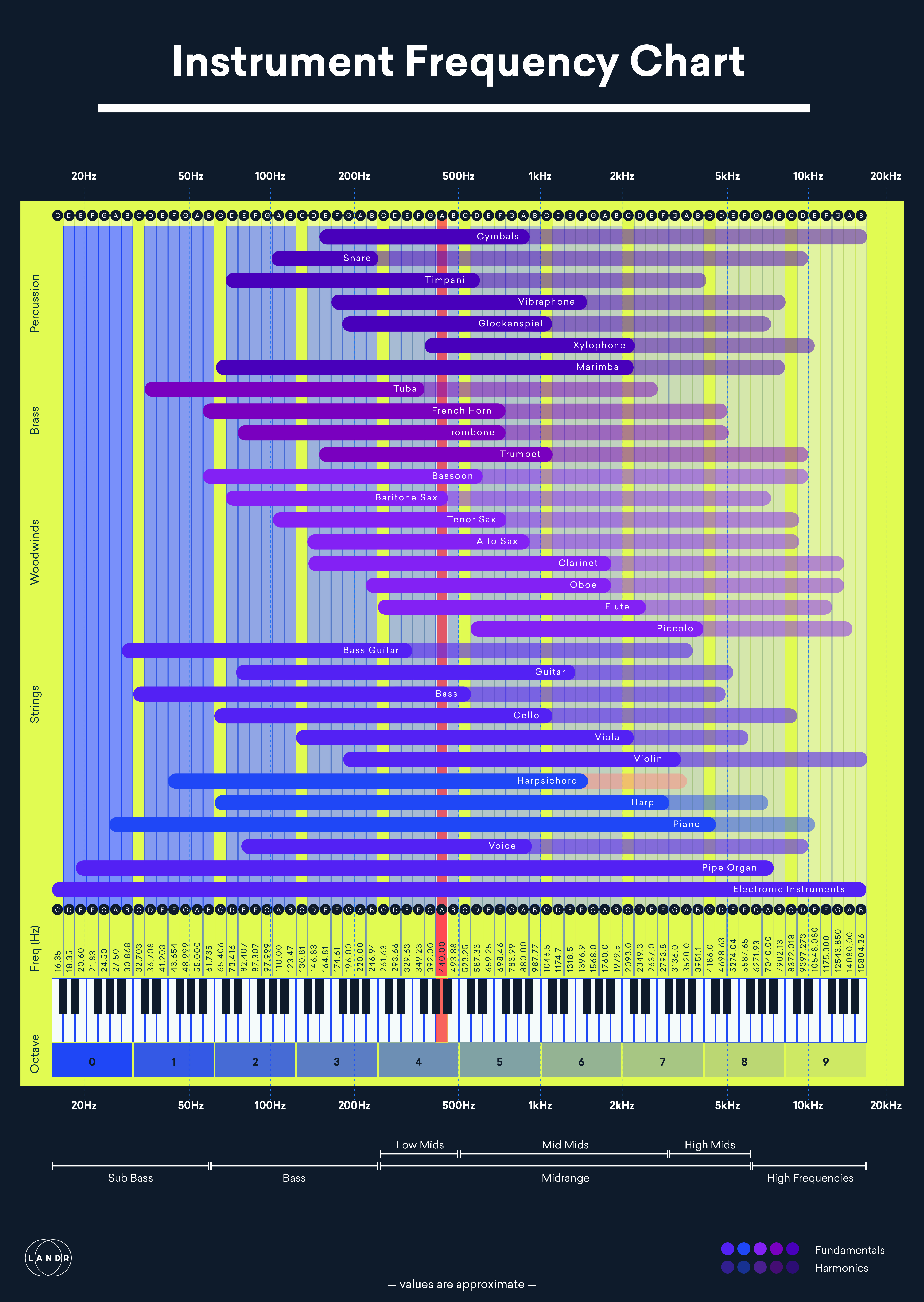
High end frequencies
Your high end starts at 5 kHz and goes up to about 12 kHz
These are the frequencies most associated with the shine and brilliance in your mix.
This is a great place for the sounds that give your mix a sense of three dimensional depth and realism to live.
I’m talking about elements like reverb, room microphones, synth pads and even vocal articulations.
The high frequencies are where the details in your mix come out so make sure not to neglect them!
It some cases you may need to boost in this range to bring out the sparkle and sheen in a sound.
Many mix engineers rely on analog-modeled EQ plugins to accomplish the delicate task of boosting high end without introducing harshness.
“Air” frequencies
The very top end of the frequency spectrum is home to an elusive quality mix engineers call “air.”
Air frequencies go from the top of the high end around 12 kHz all the way up to the extent of human hearing at 20 kHz.
As with the low sub bass, these frequencies are often more “felt” than heard. But they make a big impact.
This part of the spectrum is well outside the audible range. But these boosts are so broad that their effects radiate down through the spectrum and cause a subtle but transparent increase in the sense of “air” in the mix.
If your mix is missing this quality, consider emphasizing the air frequencies in sources that contain naturally pleasing high end information.
The Role of EQ in Mastering
While mixing involves balancing individual tracks within a song, mastering is about ensuring that the song as a whole sounds polished and consistent with other songs on an album or in the wider music market.
EQ plays a critical role in this final stage of production.
During mastering, the engineer listens to the mix in a highly controlled environment and uses EQ to correct any final frequency imbalances.
They may add a bit of sparkle to the high end, ensure the bass feels solid and defined, or scoop out a bit of muddiness in the midrange.
The goal is to make the mix sound clear, balanced, and sonically pleasing on a wide range of playback systems.
Mastering EQ is generally used with subtlety and precision.
Broad, gentle EQ curves are often preferred to drastic cuts or boosts.
This is because the mastering engineer is working with the entire mix; any EQ move will affect all the instruments, vocals, and effects in the mix.
Another key aspect of mastering EQ is correcting issues that may have been missed during the mixing process.
For example, if a mix is too bright or too bass-heavy compared to other professional releases in the same genre, the mastering engineer can use EQ to bring it more in line.
Mastering EQ can be used to enhance the sense of depth and space in a mix.
By judiciously EQing the sides differently from the center, or by using mid/side EQ techniques, the mastering can make the mix sound wider and more three-dimensional.
Advanced EQ Techniques
The world of equalization goes far beyond basic treble and bass adjustments.
Some EQ techniques offer greater control and precision in shaping your mix.
Let’s delve into some more advanced EQ techniques.
Dynamic EQ
Dynamic EQ is a powerful tool that combines the precision of an equalizer with the flexibility of a compressor.
It allows you to apply EQ changes dynamically according to the input signal level.
For instance, you can set a dynamic EQ to reduce harsh frequencies in a vocal only when they become too loud.
This way, the EQ leaves the vocal untouched when those frequencies are at acceptable volume levels.
By using Dynamic EQ you can create a more natural and transparent mixes compared to static EQ or multiband compression.
Mid/Side EQ
Mid/Side EQ is another advanced technique that involves processing the middle (mono) and sides (stereo) of a mix separately.
This allows you to shape the stereo image and depth of your mix more effectively.
For instance, you might want to boost the high frequencies on the sides to add sparkle and width to your mix, while keeping the midrange focused in the center.
Mid/Side EQ can be particularly useful for mastering, where subtle enhancements to the stereo image can make a big difference.
But be careful—too much Mid/Side processing can cause phase issues and mono compatibility problems.
Linear Phase EQ
Traditional EQs, known as minimum phase EQs, introduce phase shift around the frequencies where they apply gain or cut, which can sometimes cause issues like smearing or altering the transient response.
Linear phase EQ avoids this by ensuring that all frequencies are affected equally in terms of phase.
This can result in a cleaner, more transparent sound, particularly when making significant EQ changes.
Linear phase EQ is especially useful in mastering or when EQing groups or the mix bus.
However, it’s worth noting that linear phase EQs can introduce pre-ringing artifacts and use more CPU power.
These advanced EQ techniques can take your mixes to the next level, providing more precise control over the frequency balance and stereo image. However, they’re tools, not magic wands—understanding the principles of good mixing and knowing when to use these techniques is just as important as the techniques themselves.
EQ frequency finder
Sound frequency is one of the basic building blocks of mixing and production.
To mix and master well you need to treat each audio frequency range the right way. Getting a handle on how each part of the spectrum contributes to a balanced mix takes experience.
The recommendations in this article are only guidelines to get you started. Every mix is different and you’ll have to discover yours for yourself.
Now that you know where to start with frequencies, get back to your DAW and keep dialing in your EQs.
Gear guides, tips, tutorials, inspiration and more—delivered weekly.
Keep up with the LANDR Blog.

